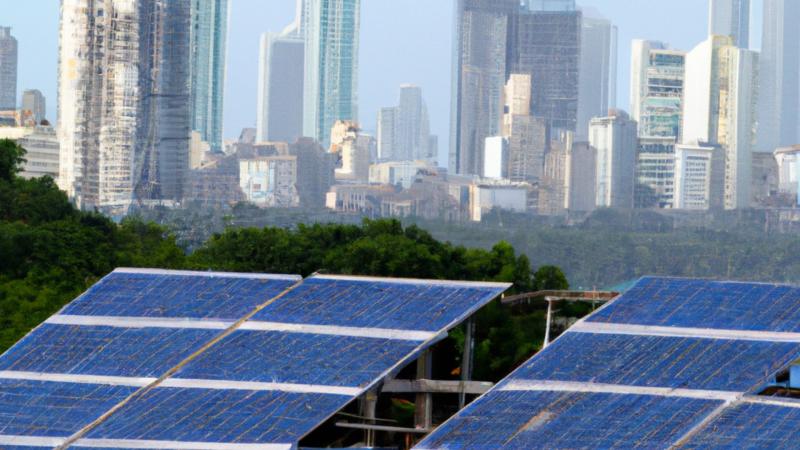
A team at the National Centre for Photovoltaic Research and Education (NCPRE) at Indian Institute of Technology Bombay (IITB) has fabricated a novel semi-transparent perovskite solar cell (PSC) and, by combining it with silicon based solar cell, has demonstrated an efficiency of more than 26% for such a cell.
Solar energy has become one of the most significant contributors to the world’s renewable energy goals However, the cost of solar energy still remains a major hurdle to overcome. Though the prices of solar panels have dropped significantly in recent years, there is still a need for more affordable solar energy solutions to make it truly ubiquitous. This is where perovskite solar cells (PSCs) come in, promising an able alternative to traditional silicon solar cells due to their low fabrication costs and high efficiency.
Perovskites are any material with a particular crystal structure, usually in the form of ABX3, where A, B and X can be atoms or molecules, like calcium titanium oxide (CaTiO3). Perovskites have gained a lot of attention since 2009, when the first perovskite solar cell (PSC) was fabricated. As one of the most abundant types of crystal structure, perovskites are cheap to produce. PSCs are also highly efficient at converting light into electricity. However, they lack the stability of conventional solar cells, like the ones made of silicon, and often degenerate when exposed to light, heat or applied voltage for extended periods of time.
The team at IIT Bombay has overcome the stability issue by combining their PSC with a silicon solar cell in what is called a tandem configuration. Combining the two different types of solar cells allows the device to convert more of the light falling on it into electricity. Apart from the higher efficiency, the tandem architecture also provides greater stability to the device, while driving its overall lifetime costs low.
“Perovskite solar cells are known for their high-power conversion efficiency and lower production cost; however, they are lagging in terms of their stability. However, in our work we have fabricated a stable 4T (four terminal) Si/perovskite tandem solar cells which provides an outstanding stability in dark as well as continuous heating conditions” remarks Prof. Dinesh Kabra, a professor at IITB and an author of the new study.
A 4T tandem device, as the name suggests, has four terminals, two for each of the layers of the tandem device. This allows for precise measurements of the solar cell’s performance, while also improving the device’s efficiency and lifetime.
For their study, the team first fabricated a PSC from a thin film of perovskite, which is transparent to near InfraRed light (low frequency light). The transparency makes them very useful in several devices, including in building integrated photovoltaic (BIPV), vehicle integrated photovoltaic (VIPV) etc. The PSC was then measured for its power conversion efficiency (PCE), which measures the amount of light that is being converted into electricity. The PSC recorded very high efficiencies of 17.1% for a small area (0.175cm2) PSC and 16% for a large area (0.805cm2) PSC.
However, the PSC thus fabricated is not as stable as a conventional silicon solar cell. To address this, the researchers turned to tandem device architecture. Instead of using the PSC by itself, they layered it on top of a commercially available silicon solar cell, called Passivated Emitter and Rear Contact (PERC) silicon solar cell. The new tandem structure was far more resilient and stable under different environmental conditions, with a higher demonstrated efficiency. Although the PSC could still degenerate faster than the silicon cell, the fabrication allows for the top PSC layer to be easily replaced.
“In our case i.e., in 4T tandem configuration when the top low-cost perovskite solar cells fail, there is a possibility to replace the top cells with a new one because our tandem device is only optically coupled so, it can enhance the lifetime of the overall devices” says Prof. Kabra.
The researchers also demonstrated a very high 26% power conversion efficiency for the tandem device, which is one of the highest recorded efficiencies for such a device.
“Since there is huge interest in Si/perovskite tandem solar cells, lots of high efficiency results are coming from the industry, but do not reveal the device architecture and it’s not too useful for academic research progress. Our report not only shows the complete device architecture but also explains the fabrication process, as a typical practice of academic research” remarks Prof. Kabra about the academic importance of their work.
More importantly, the device also lowers the levelized cost of energy (LCOE) for tandem solar cells. LOCE measures the cost of electricity for different methods of electricity generation. For example, it can be used to calculate how much one can save on the electricity bill by switching to solar power generation.
With more countries around the globe adopting renewable energy sources, the role of solar power generation is set to become ubiquitous, with perovskites taking a lead role. More research and development are required however to be able to introduce perovskite solar cells, and tandem devices based on them, on a commercial scale. In this context, the new study from IITB forms a base of a vast amount of knowledge that is yet to be generated.






